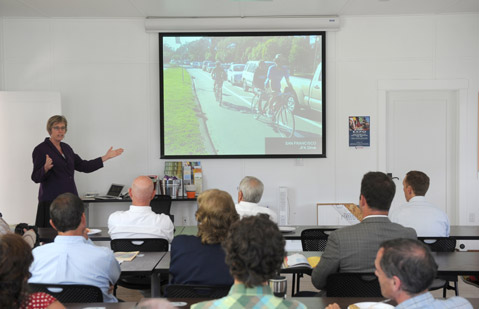More Street Space for Bikes?
Bicycling Expert Spreads the Gospel of Green Lanes

The biggest barrier to cycling is safety, said Martha Roskowski, a national leader in bicycling advocacy. That’s why she is singing the praises of green lanes, protected bicycle lanes that are separated from car traffic by a physical barrier.
A former lobbyist who helped craft the Federal Transportation Bill, Roskowski now heads up the Bikes Belong green lane project run by the national People for Bikes organization. Bikes Belong is a nonprofit entity aimed at installing protected bike lanes in cities across the country. The six participants now are Austin, Chicago, Memphis, Portland, San Francisco, and Washington, D.C.
At the behest of People for Bikes boardmember and president of Trek Bicycles John Burke — who owns a home in Santa Barbara — Roskowski visited the South Coast on a two-day blitz that included five presentations. Her last was attended by an audience of environmentalists, Councilmember Bendy White, City Council hopefuls Gregg Hart and Megan Diaz, and representatives of the business sector such as Downtown Organization President Bill Collyer. On a day when President Barack Obama announced his plan to attack climate change, Roskowski was not preaching the environmental benefits of bicycling. She was here to sell green lanes as a boon to urban resiliency, health, and economic vitality.
“You cannot be for a startup, high-tech economy and not be pro-bike,” she quoted Chicago Mayor Rahm Emmanuel, who has pledged 100 miles of green lanes in downtown Chicago and has already built 30. As young adults gravitate to walkable, bikeable, urban environments, companies are relocating from the suburbs. From 2001 to 2009, the amount of driving by 16- to 34-year-olds dipped 23 percent — from 10,300 miles to 7,900.
Merchants, as well, have benefited from shoppers who travel via foot- or pedal-power. A 2012 Penn State study found they visit stores more often and spend more per month. Members of the business community at Tuesday’s presentation pressed Roskowski on the issue of parking spaces, however, worrying that real estate given to bipedalists will steal space from drivers. She responded that any area that people want to visit has a parking problem that will never be completely solved. Portland, Seattle, and San Francisco have been pushing the envelope by converting parking spots to bike parking or “parklets” that restaurants can use for sidewalk seating in order to increase pedestrian traffic.
Roskowski did not extol a utopian vision of a car-less society. In fact, she believes the biggest increase in cycling will be for short hops to the frozen yogurt shop rather than commutes to work. And she conceded that green lanes necessarily take the space of either car lanes or parking spaces. Politically, she said, it is easier to convert travel lanes because people get emotionally attached to parking spots. At the least invasive, building green lanes requires a paint job and the installation of a barrier like posts or planters.
Hart, who works for the Santa Barbara County Association of Governments, which focuses largely on traffic and planning, asked how a city can get involved in the Bikes Belong initiative. Roskowski said that when mayors are invited to apply in August, she will look at community support, foundation support, projects already in the pipeline, and — most importantly — political will. One of the less obvious participants, Memphis was rated as the worst city for cycling by Bicyling magazine in 2008. But the current mayor — concerned about obesity and diabetes among African Americans — fired his head of transportation and made bicycling infrastructure a priority.
From what she had seen in her admittedly brief two-day visit in Santa Barbara, Roskowski said the street system “does not call to me as a bicyclist.” We have a good base infrastructure that is 20 to 30 years old, she said, but we “are not currently being proactive,” adding, “If you guys decided you wanted to get to the next level, you could do it.”
The City of Santa Barbara will have that opportunity as it is embarking — with Measure A funds — on updating its bike master plan, last revamped in 1998. “The reality is we don’t have any significant projects even in the planning stage right now,” said Ed France, executive director of the Santa Barbara Bicycle Coalition, and until the master plan is complete, it won’t. Furthermore, the area has seen little recent innovation while cities like Berkeley have installed bike boulevards. “It’s like we’re in a footrace, and we started out really good,” said France, “and now we’re in a stage where everybody is passing us and at a rather fast pace.”



